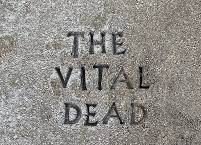

Alison Bell is Professor of Anthropology at Washington and Lee University. This interview is based on her new book, The Vital Dead: Making Meaning, Identity, and Community through Cemeteries (University of Tennessee Press, 2023).
JF: What led you to write The Vital Dead?
AB: For many years I’ve loved to wander through cemeteries, reading epitaphs and admiring carved lilies and willow trees. About a decade ago I started noticing some surprising recent grave markers that depicted pickup trucks and sports logos. One grave marker had a gas station, one a VW Bug, one an emu. The gravestone that really amazed me featured a quintet of “Monsters from the Vault”: the Mummy, Dracula, the Creature, Frankenstein’s Monster, and the Wolf Man (stone of Dennis Lee Clatterbaugh, 1956–2010, Thornrose Cemetery, Staunton). When I saw this grave marker in 2015, I became committed to researching cemeteries to try to understand social and cultural dynamics informing these innovations in mortuary imagery and remembrance. Since then I’ve visited more than 140 cemeteries in nineteen counties in the Valley of Virginia – from Frederick in the north to Wythe in the south – plus cities like Winchester, Harrisonburg, and Roanoke and small communities in Giles, Highland, Bland, and Bath counties.
JF: In 2 sentences, what is the argument of The Vital Dead?
AB: Cemeteries are public, visible material expressions of social and cultural dynamics. In some ways, recent changes in memorialization mark an extraordinary moment, a unique pivot point in cultural and civic experience, but in other ways these developments represent something like a swinging of the pendulum back to earlier values of social and familial connection that transcend death.
JF: Why do we need to read The Vital Dead?
AB: Through epitaphs, images on headstones, and gifts left on graves, people assert their understandings of whose lives mattered, who represents the family and community, and what values should be upheld. The Vital Dead traces these currents from the mid-eighteenth century to the present through asylum cemeteries, African American burying grounds, Confederate memorials, municipal cemeteries, and resting places affiliated with a wide range of religious denominations in the Valley. People who’ve read the book say it made them both laugh and cry.
JF: Why and when did you become an American historian?
AB: I might be considered “historian adjacent”: I study the American past but am definitely a historical archaeologist and anthropologist (rather than a historian). I’ve been interested in archaeology since I was a child reading National Geographic. My first year at college, I enrolled in a field archaeology class that focused on an historic pottery kiln, and soon after that I read Jim Deetz’s book, In Small Things Forgotten: The Archaeology of Early American Life. I was thunderstruck by the ways that historical archaeologists try to use “everything there is” – artifacts, architecture, cemeteries, archival records, oral history and more – to understand more about the American past.
JF: What is your next project?
AB: With Washington and Lee University alumna and attorney Tammi Simpson, I’m writing a book about school desegregation in western Virginia. It’s based largely on oral history interviews that the late Theodore C. DeLaney, W&L History Professor Emeritus, conducted. Before passing in 2020, he asked me to complete and publish this research. The manuscript is tentatively entitled, “This Movement Toward Equality”: School Desegregation in Virginia’s White Belt through the Research of W&L History Professor Theodore DeLaney.
JF: Thanks, Alison!